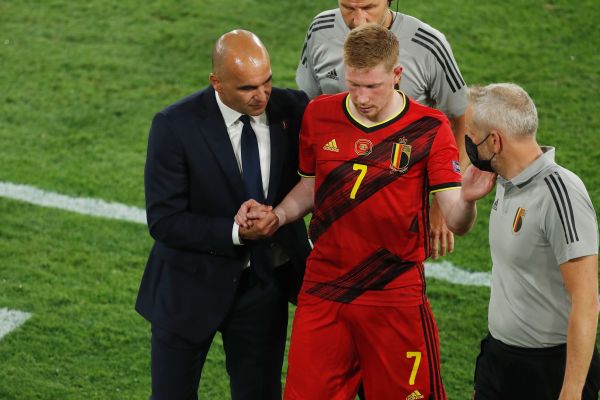Belgium star Kevin De Bruyne has fallen victim to bad challenges in this year’s Champions League final and again at Euro 2020.
Go back to the first time a major international football tournament concluded at Wembley and Pele never got there. He was kicked out of the 1966 World Cup by the Bulgarians and the Portuguese as Brazil’s defence of their crown ended in the group stages.
Rewind the best part of three decades and Marco van Basten’s Champions League final came to a premature conclusion. He never recovered from a foul from Basile Boli, though the hacks many a Serie A defender took at his ankles before then definitely took their toll. AC Milan’s 1993 defeat by Marseille proved their talisman’s final game: for them or for anyone.
Many want to emulate Pele and Van Basten. Kevin De Bruyne threatens to do so in unwanted fashion. It is to be hoped he can take the field for Belgium against Italy in Friday’s quarter-final, and potentially in a semi-final and final thereafter, but it is sadly possible the last sightings of him on the field for club and country in the 2020-21 season are of a disconsolate De Bruyne departing injured.
He fractured an eye socket and his nose in a collision with Antonio Rudiger in the Champions League final. He hurt his ankle when fouled by Portugal’s Paulinha this past Saturday. The rules have been adjusted since Pele and Van Basten’s days; indeed the tackle from behind became a red-card offence as a result of the Dutchman’s treatment. It is no longer as easy to kick a player out of the game and stay on the pitch.
It is a moot point if either tried. Rudiger denied his full-blooded collision was intentional and the injuries stemmed in part from his formidable physique but the normally measured and mild-mannered Roberto Martinez called it “reckless” and deserving of a red card.
Palhinha may have been more desperate than cynical when De Bruyne burst past him; the increasingly infamous Seville pitch may have hurt the midfielder more. And yet Palhinha had brought him down earlier; he was taking on the appearance of the resident hatchet man, determined to stop De Bruyne, whether by fair means or foul.
Whichever, De Bruyne felt luckless. Twice there has been the sense that this is his year, the stage when he establishes himself as the world’s greatest midfielder, when he takes club or country to unprecedented heights. Twice his body has given way, through no fault of his own.
He was outstanding in the Champions League quarter- and semi-final triumphs over Borussia Dortmund and Paris Saint-Germain and if he had been underwhelming in the opening hour against Chelsea, his ability to produce the spectacular means that could have changed if he stayed on the pitch. He might have made Manchester City champions of Europe for the first time.
Instead, his facial injuries delayed his introduction to Euro 2020. When it came, it was dramatic. His catalytic second-half show against Denmark transformed defeat into victory. It was a reminder of his capacity to bend a game to his will with a blend of drive and quality. There are matches when it feels that it scarcely matters who the other 21 players on the pitch are because De Bruyne’s team will win. This was one.
Factor in a man-of-the-match display against Finland and De Bruyne’s European Championships was gathering pace; until he was hobbling off, Belgium saying he would be assessed. Perhaps there will be a desperate attempt to patch him up, especially with Eden Hazard also hurt. No doubt De Bruyne will be willing to play if semi-fit.
The isolated nature of major tournaments mean they assume all-or-nothing proportions. With De Bruyne turning 33 during the next Euros, his dynamism presumably drained by then and his Gerrard-esque bursts past opponents altogether rarer, this was shaping up as his best chance to conquer the continent and power Belgium to their first trophy.
In both blue and red, 2021 shaped up as the year could give De Bruyne his defining achievement. Ill-fortune and injury may yet deprive him twice.





